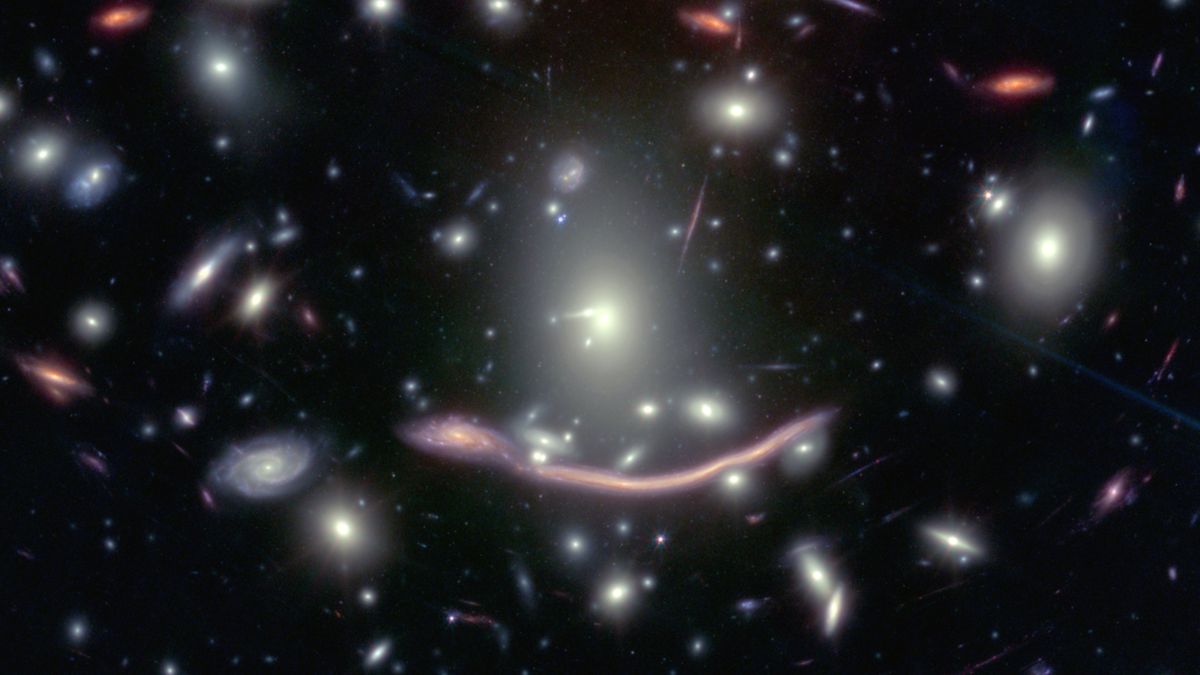Astronomers armed with exceptionally detailed James Webb Space Telescope (JWST) images have discovered dozens of ancient stars from a distant, gravitationally warped galaxy. The stellar haul, which was uncovered thanks to a space-time phenomenon predicted by Einstein, is the largest of its kind ever seen so far away.
The newly imaged stars are located within the “Dragon Arc,” a spiral galaxy roughly 6.5 billion light-years from Earth when the universe was around half its current age. Normally, such distant stars are too far away to be seen in detail. But part of the Dragon Arc has been magnified by gravitational lensing, a phenomenon first predicted by Albert Einstein‘s theory of general relativity in 1915.
Gravitational lensing occurs when light from a distant object passes through space-time that’s been bent out of shape by the immense gravity of another massive object located between the distant object and the observer. This mishaped space-time magnifies the distant object’s light and warps it into new shapes, such as circular halos known as Einstein rings. In this case, light from the Dragon Arc has been warped by the gravity of Abell 370 — a cluster of galaxies located roughly 4 billion light-years from Earth. As a result, the distant galaxy has been stretched out into an arc of magnified light.
In a study published Jan. 6 in the journal Nature Astronomy, researchers zoomed in on new JWST images of Abell 370 and spotted 44 individual stars within the Dragon Arc’s warped tail of light. This was a surprise to the researchers, who were originally searching for never-before-seen lensed objects that might be hiding behind the galaxy cluster.
“When we discovered these individual stars, we were actually looking for a background galaxy that is lensing-magnified by the galaxies in this massive cluster,” study co-author Fengwu Sun, a postdoctoral researcher at the Harvard and Smithsonian Center for Astrophysics, said in a statement. “But when we processed the data, we realized that there were what appeared to be a lot of individual star points.”
Related: James Webb telescope uncovers 1st-ever ‘Einstein zig-zag’ hiding in plain sight — and it could help save cosmology
Until now, the largest groups of individually imaged stars spotted beyond our nearest galactic neighbors, such as the Andromeda Galaxy, contained up to seven stars, researchers wrote. “This groundbreaking discovery demonstrates, for the first time, that studying large numbers of individual stars in a distant galaxy is possible,” Sun said.
Spying distant stars
Although telescopes have long been capable of spotting extremely distant galaxies, images of these far-flung neighborhoods are often extremely faint and fuzzy, which can make it hard to resolve any of their main features — let alone any of the billions of stars they might hold. The few lone stars scientists have been able to observe have been largely spotted thanks to gravitational lensing.
But the launch of JWST has changed the game. The state-of-the-art telescope is exceptionally good at finding and resolving gravitationally lensed objects, which has helped to open up new windows into the hearts of warped galaxies like the Dragon Arc.
The telescope’s infrared sensors also enable scientists to measure the temperatures of distant objects, which helps researchers identify them. For example, the authors of the new study determined that a large majority of the 44 newfound stars are “red supergiants” — the largest-volume stars in the universe. By studying these newfound stars further, the researchers hope to learn more about how similar red supergiants within the Milky Way may have evolved.
The researchers will now hunt for more stars within the warped light of the Dragon Arc and other distant galaxies to try and answer bigger questions about the cosmos, such as how different types of galaxies form and the mysterious identity of dark matter. But they may need to find even more stars to get reliable results.
“To study stellar populations in a statistically meaningful way, we need many more observations of individual stars,” study lead author Yoshinobu Fudamoto, an assistant professor at Chiba University in Japan, said in the statement.
